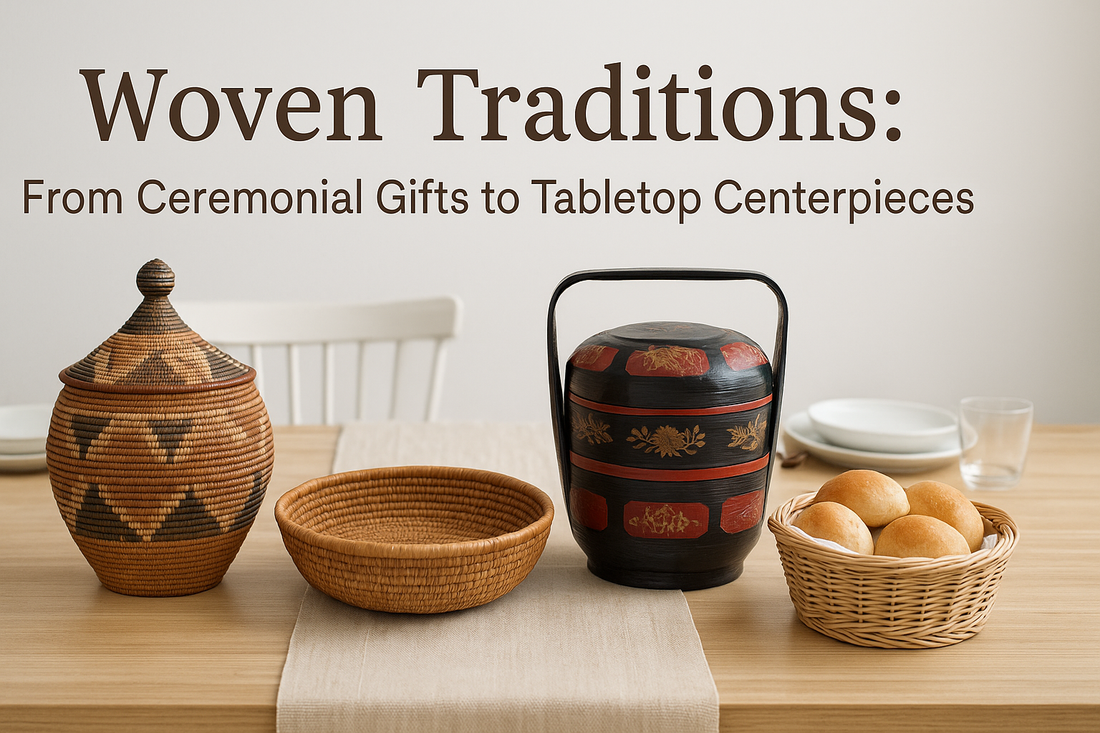
Woven Traditions: From Ceremonial Gifts to Tabletop Centerpieces
Share
For millennia, handwoven baskets have crisscrossed the globe as symbols of plenty, union, and hospitality. A South African bride-to-be patiently stitches a basket of dyed palm strips—a gift that will carry ritual beer on her wedding day. In a Peranakan Chinese community, lacquered tiered baskets brimming with sweets and oranges bless the newlyweds. Native American and Pacific Islander cultures likewise wove intricate baskets for weddings, harvests, and rites of passage.
Over time, these utilitarian and symbolic vessels migrated from ceremonies into kitchens and dining rooms. Today, the same craft that once carried dowry gifts now holds bread, fruit, and décor on our tables. Let’s trace this journey—through Africa, Asia, Europe, and the Americas—from the age-old wedding basket to the modern home centerpiece.
Asia: Auspicious Baskets and Dowry Carriers

In Southeast and East Asia, wedding gifts often traveled in ornate baskets. Among Peranakan communities in Malaysia, Singapore, and Indonesia, tiered lacquered baskets called bakul siah (“auspicious baskets”) played a starring role. Painted red or black with gold double-happiness symbols, they carried cakes, tea sets, jewelry, and wedding rings during elaborate ceremonies.
Traditional Chinese weddings also used dowry baskets, often split into tiers for food, spices, and ceremonial items. In South India and Bali, weddings included baskets of betel nuts, coins, or fruits as offerings. Even sewing baskets had symbolic value: in Guangdong, a “bridal sewing basket” with spools of thread represented fertility.
Modern Decor Tip: Today, woven rattan trays inspired by these heirlooms appear in cafes and home dining tables. Tiered wicker carriers hold sushi or desserts at hip restaurants, while antique Chinese wedding baskets are restored as side tables or serving stands.
Africa: Ceremonial Weaves and Wedding Baskets

Across Africa, basketry is interwoven with life’s milestones. In South Africa’s Zulu culture, girls learn to weave baskets as part of coming-of-age traditions. Large ilala-palm baskets are traditionally woven by a bride-to-be or gifted to a new couple to hold ceremonial beer on their wedding day. Patterns and colors tell stories: checkerboards and spirals mean good news; diamonds and triangles often symbolize “wedding basket” motifs.
These baskets can take months to make, and are prized family heirlooms. In West Africa’s Sahel region, the Mossi people of Burkina Faso braid deep reed baskets used in weddings and harvest ceremonies—linking prosperity in the fields to prosperity in marriage.
Modern Decor Tip: Brightly colored Zulu ilala baskets with whirl or diamond patterns are popular as wall art or tabletop bowls. Coiled wire baskets from Kenya or Rwanda’s classic agaseke add global flair to dining rooms with their storytelling designs.
The Americas: Navajo Blessing Baskets and Cornucopias

In North America, Indigenous cultures wove baskets for ceremonies and gifting. The Navajo wedding basket is a sacred icon. Traditionally made from sumac, these baskets hold blue cornmeal dough during the wedding ritual—a symbol of unity. Designs feature white starbursts for beginnings, with black and red bands representing joy and life. After the ceremony, the basket is displayed at home facing east to invite prosperity.
Colonial settlers brought European basket traditions, using hickory or wood-ash baskets for harvest and weddings. The “cornucopia” or horn of plenty became a key decorative symbol. Wooden dough bowls originally used for kneading bread now serve as rustic centerpieces in modern homes.
Modern Decor Tip: Shallow woven baskets or wooden dough troughs make perfect fruit bowls or bread baskets, adding natural texture and a sense of abundance to any table.
Europe: Hampers and Wicker Gifts

In medieval Europe, woven baskets were essential for gifting food and wine. The word hamper comes from Old French hanapier, meaning a case for goblets. By Victorian times, the Christmas hamper evolved into a luxurious seasonal gift filled with cheeses, wines, and treats.
Although specific wedding baskets faded in modern Europe, the spirit of gifting in baskets survived. From Christmas hampers to picnic baskets, the tradition of presenting food in woven carriers continues to symbolize hospitality and abundance.
Modern Decor Tip: European-style picnic baskets or wicker hampers make charming storage solutions in dining rooms or kitchens, doubling as décor when not in use.
Baskets as Dining Decor: Practical Styling Ideas
Today’s designers love baskets for their warmth and texture. Here are some ways to bring traditional basketcraft to your modern dining table:
- Bread Baskets: Line a woven basket with a cloth napkin to hold rolls or baguettes. Natural fibers keep bread warm and create an artisanal, casual look.
- Fruit Bowls: Use a round, shallow basket or wooden trough as a fruit bowl centerpiece. Fill it with seasonal fruit for a pop of color and rustic charm.
- Floral Arrangements: Place a jar or liner inside a basket to use it as a vase. Arrange flowers or branches for a striking centerpiece with natural texture.
- Wall Displays: Hang a collection of flat baskets on your dining room wall for an artistic, folk-inspired installation.
- Condiment Trays: Use a low, lidded basket to corral condiments, napkins, or utensils on a buffet or sideboard.
- Layered Place Settings: Add wicker chargers under dinner plates to introduce texture and a global-eclectic vibe.
In Essence
The humble basket has journeyed from ceremonial gift-carrier to the heart of our homes. Once a vessel for dowries and blessings, it now carries daily bread and brightens our tables. By weaving traditional basket forms into our dining decor, we honor centuries of craftsmanship and storytelling—turning every meal into a small act of cultural memory and celebration.
